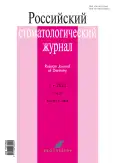Influence of a colloidal silver dioxide solution on the edge adjustment of the mineral aggregate trioxide cement for closure of perforation communications in vitro
- Authors: Kozlova I.V.1, Kovalevsky A.M.1, Vorobieva J.B.1, Zheleznyak V.A.1
-
Affiliations:
- Kirov Military Medical Academy
- Issue: Vol 27, No 1 (2023)
- Pages: 5-14
- Section: Experimental and Theoretical Investigation
- URL: https://journals.rcsi.science/1728-2802/article/view/133027
- DOI: https://doi.org/10.17816/dent290103
- ID: 133027
Cite item
Abstract
BACKGROUND: According to Russian and foreign literature, the probability of iatrogenic perforation of the wall of the tooth root canal is high (9.7–12.5%) during endodontic dental treatment. This is a poor prognostic sign and may subsequently result in tooth extraction. Moreover, cases without curing of mineral trioxide aggregate (MTA) cement with pronounced exudation were reported. Сurrently, the modification of domestically produced MTA cement is relevant for closing teeth root canal perforation.
AIM: This study aimed to conduct a comparative experimental microscopic study of the preservation of the marginal fit to the tooth tissues in perforation areas filled with MTA cement mixed conventionally with distilled water and a colloidal silver dioxide solution.
MATERIALS AND METHODS: Sixty teeth previously removed for medical reasons were endodontically treated after iatrogenic perforation formation in the furcation area of the roots. Two groups were formed. In the first group, MTA cement mixed with distilled water was used to close dental perforations. In the second group, MTA cement mixed with a colloidal silver dioxide solution was utilized. The groups were divided into subgroups depending on the MTA cement brand used. The teeth were placed in an automatic incubator HHD 7 LED, in which an optimal mode was created, simulating the conditions of the oral cavity (t = 37 °C, humidity 99%). The samples were placed in artificial saliva. After two months of exposing the teeth to a humid environment, the preservation and damage to the marginal fit in the perforation area of the fillings were determined under a Levenhuk 720B binocular microscope.
RESULTS: In the perforations of the 30 teeth sealed with various MTA cement types mixed with distilled water, damage of the marginal fit was found in seven (23.3 ± 7.9%) cases. Similar damage in 30 teeth with colloidal silver dioxide solution used to prepare MTA cements was detected in two (6.7 ± 4.6%) cases (p >0.050, t = 1.82).
CONCLUSION: The use of MTA cement mixed in a colloidal silver dioxide solution, in comparison with distilled water, contributes to a greater preservation of the marginal fit of the material to the walls of the root canal in an in vitro experiment.
Full Text
##article.viewOnOriginalSite##About the authors
Ivanna V. Kozlova
Kirov Military Medical Academy
Email: kozlova.ivanna@list.ru
ORCID iD: 0000-0001-8143-3518
SPIN-code: 1659-4870
Student
Russian Federation, 37 Academician Lebedeva street, 194044, Saint PetersburgAlexander M. Kovalevsky
Kirov Military Medical Academy
Email: endy_taker@mail.ru
ORCID iD: 0000-0002-0772-0663
SPIN-code: 6899-4345
MD, Doc. Sci. (Med.), Assistant Professor
Russian Federation, 37 Academician Lebedeva street, 194044, Saint PetersburgJulia B. Vorobieva
Kirov Military Medical Academy
Email: doctor32@bk.ru
ORCID iD: 0000-0003-0394-7868
SPIN-code: 9690-1182
MD, Cand. Sci. (Med.), Assistant Professor
Russian Federation, 37 Academician Lebedeva street, 194044, Saint PetersburgVladimir A. Zheleznyak
Kirov Military Medical Academy
Author for correspondence.
Email: zhva73@yandex.ru
ORCID iD: 0000-0002-6597-4450
SPIN-code: 3895-3730
MD, Cand. Sci. (Med.)
Russian Federation, 37 Academician Lebedeva street, 194044, Saint PetersburgReferences
- Farea M, Husein A, Pameijer CH. Furcation perforation. Current approaches and future perspectives. Endododontic Practice. 2018;11:25–31.
- Narbekova KA, Sinichkin VS, Shirshikova AA, et al. Methods of closing perforations. Mezhdunarodnyj studencheskij nauchnyj vestnik. 2018;1:17. (In Russ).
- Shorina TV. Neanalogi. Dentaltimes. 2017;36:54–56. (In Russ).
- Slabun T. Klinicheskij sluchaj lechenija zubov s poperechnym perelomom kornja u pacienta pozhilogo vozrasta. DentArt. 2005;3:15–23. (In Russ).
- Klimpel’ FM. Ispol’zovanie MTA dlja retrogradnogo plombirovanija v jendodontii. Kafedra. Stomatologicheskoe obrazovanie. 2015;43:62–65. (In Russ).
Supplementary files












